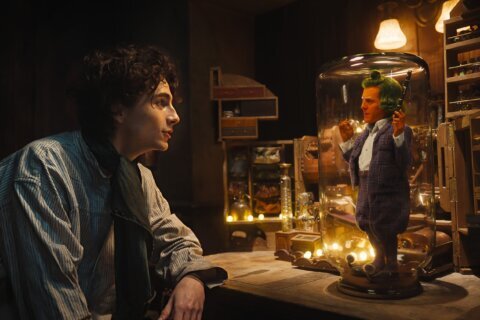WASHINGTON – Labor Day weekend is upon us, signaling the symbolic end of summer.
Time for a postmortem on the Summer Blockbuster Season.
Hollywood is touting 2013 as the highest-grossing summer ever at the domestic box office, expected to bring in $4.7 billion, breaking the 2011 record of $4.4 billion.
But let’s not all dive into the Scrooge McDuck money pit just yet.
A different picture emerges when you consider two key points:
1.) Bread once cost a nickel
Today’s movies naturally gross more because money is worth more, due to inflation. In sheer dollars, the highest grossing movies of all time are No. 1 “Avatar” (2009), No. 2 “Titanic” (1997), No. 3 “The Avengers” (2012) and No. 4 “The Dark Knight” (2008). However, if you adjust for inflation – the only fair way to do it – “Avatar” drops to No. 14, “The Avengers” drops to No. 27 and “The Dark Knight” drops to No. 29. The real Mount Rushmore thus becomes: No. 1 “Gone With the Wind” (1939), No. 2 “Star Wars” (1977), No. 3 “The Sound of Music” (1965) and No. 4 “E.T. The Extra Terrestrial” (1982).
The same holds true for this summer. “Iron Man 3” was the top-grossing movie of the year, but if you adjust for inflation, it ranks No. 101. Yup – the best blockbuster this year had to offer doesn’t even crack the Top 100 of all-time moneymakers. Similarly, “Despicable Me 2” was No. 2 this year, but ranks No. 146 all-time with inflation. “Man of Steel” was No. 3 this year, but doesn’t even make the all-time Top 200. The takeaway? These three flicks look like they did well week-to-week in 2013, but they’re barely blips on the historical radar. It’s ridiculous to think Hollywood is cooking with gas.
2.) Totals are different than profits
Rather than looking only at the total box office receipts (money coming in), we must also look at what it cost to *make* each of these blockbusters (money going out). When you crunch the numbers, you’ll see that many studio tent-poles lost more than they made domestically. What do we mean by tent-pole? Usually we’re talking a movie with a $100 million budget, but for our sake, let’s lower it to $75 million, just to include more movies. Here’s how the cost-to-gross ratio played out domestically:
DOMESTIC SUMMER FLOPS
- “The Lone Ranger” – cost $215 million, grossed $88 million (-$127 million)
- “R.I.P.D.” – cost $130 million, grossed $32 million (-$98 million)
- “Pacific Rim” – cost $190 million, grossed $99 million (-$91 million)
- “White House Down” – cost $150 million, grossed $72 million (-$78 million)
- “After Earth” – cost $130 million, grossed $60 million (-$70 million)
- “Turbo” – cost $135 million, grossed $79 million (-$56 million)
- “Elysium” – cost $115 million, grossed $70 million (-$45 million)
- “The Smurfs 2” – cost $105 million, grossed $63 million (-$42 million)
- “Red 2” – cost $84 million, grossed $51 million (-$33 million)
- “Oblivion” – cost $120 million, grossed $89 million (-$31 million)
- “G.I. Joe: Retaliation” – cost $130 million, grossed $122 million (-$8 million)
MILD SUCCESSES
- “Now You See Me” – cost $75 million, grossed $116 million (+$41 million)
- “The Great Gatsby” – cost $105 million, grossed $144 million (+$39 million)
- “Star Trek: Into Darkness” – cost $190 million, grossed $227 million (+$37 million)
- “Olympus Has Fallen” – cost $70 million, made $98 million (+$28 million)
- “Oz: The Great and Powerful” – cost $215 million, grossed $235 million (+$20 million)
- “Planes” – cost $50 million, grossed $62 million (+$12 million)
- “World War Z” – cost $190 million, grossed $199 million (+$9 million)
- “The Hangover Part III” – cost $103 million, grossed $112 million (+$9 million)
- “Epic” – cost $100 million, grossed $107 million (+$7 million)
- “The Wolverine” – cost $120 million, grossed $125 million (+$5 million)
BLOCKBUSTER HITS
- “Despicable Me 2” – cost $76 million, grossed $351 million (+$275 million)
- “Iron Man 3” – cost $200 million, grossed $408 million (+$208 million)
- “Fast & Furious 6” – cost $160 million, grossed $238 million (+$78 million)
- “Man of Steel” – cost $225 million, grossed $289 million (+$64 million)
- “Monsters University”– cost $200 million, grossed $261 million (+$61 million)
Domestic box office statistics courtesy of Box Office Mojo.com
![]()
Domestic Trends
What can we discern from these box office stats? A few things:
1.) Animated features are still smart bets. It’s no coincidence that two of the four top-grossers are animated; family outings remain king of the box office. “Despicable Me 2” cost just $76 million to make but grossed $351 million. Disney never released budget info on “Monsters University,” but most estimates are around $200 million, while grossing $261 million. Pixar’s “Planes” made a slight profit at $12 million, as did “Epic” at $7 million. “Smurfs 2” was the exception to the rule, losing $42 million.
2.) Cheap comedy and horror works. Melissa McCarthy scored big with two low-budget buddy comedies. “The Heat” cost just $43 million, but grossed $156 million, while “Identity Thief” cost just $35 million, but grossed $134 million. That makes both more profitable than “Fast & Furious 6,” “Man of Steel” and “Star Trek: Into Darkness.” As for horror, “The Conjuring” cost just $20 million, but grossed $127 million, while “The Purge” cost just $3 million, but grossed $64 million.
3.) Modest biopics bring decent returns on investment. The Jackie Robinson tale “42” cost just $40 million, but made $95 million. “The Butler” cost just $30 million, but made $55 million. On the flip side, “Jobs” barely broke even. The catch: American biopics don’t have as much upside overseas.
4.) Re-releasing can be more profitable than remaking. The “Jurassic Park” transfer to 3D cost just $10 million, but grossed $45 million. That’s a $35 million profit, better than a prequel like “Oz: The Great and Powerful,” a sequel like “The Hangover Part III” or a superhero reboot like “The Wolverine.” Last year, “Titanic 3D” cost just $18 million but grossed nearly $58 million. That’s a bigger profit than remaking “The Great Gatsby.” Perhaps more theaters will “play the hits,” choosing to revive rather than remake – or as “Jurassic Park” would put it, extracting film DNA from fossilized amber.
![]()
The (Hollywood) State of the Union
Clearly Hollywood is content with letting films flop domestically, banking on foreign sales and Video on Demand to pick up the slack. But how long can it sustain itself while alienating domestic viewers? And what will that do to Blu-Ray prices as these outlets try to pick up more and more of the slack?
Earlier this summer, Steven Spielberg and George Lucas predicted the collapse of the studio system during a panel at the USC School of Cinematic Arts.
“There’s eventually going to be a big meltdown,” Spielberg said. “There’s going to be an implosion where three or four or maybe even a half-dozen of these mega- budgeted movies go crashing into the ground and that’s going to change the paradigm again.”
Lucas predicts we will return to the days of the big movie palaces, but with much higher ticket prices.
“Going to the movies will cost 50 bucks or 100 or 150 bucks, like what Broadway costs today, or a football game,” said Lucas, who ironically helped create this very problem. “(Movies) will sit in the theaters for a year, like a Broadway show does. That will be called the ‘movie’ business.”
Spielberg and Lucas aren’t exactly ahead of the curve in this prediction; the writing has been on the wall for years. I believe we’ve reached a tipping point for five main reasons:
1.) Cost
You’ve seen it in your own pocketbook: It pays to be cautious about when and where you go to the movies. Last month, the National Association of Theater Owners announced record highs for ticket prices, the average jumping from $7.96 last year to $8.38 this year. It can be considerably more if you see the movie in 3D IMAX. A trip to “The Wolverine” this weekend in RealD 3D will cost you $16.50 in D.C. Add popcorn and soda for a family of five and it’s an expensive night out. Matinees are key.
2.) Alternatives
Today’s viewers have many more options for watching. Decades ago, there was only network television. Then came cable TV, where channels such as Home Box Office re-aired movies after their original theatrical run. Then came video stores with straight-to-video releases. That trajectory resulted in Video On Demand (VOD), where various titles (new and old) are now instantly available with the click of a button on your cable or satellite guide, or streaming online via Netflix, iTunes or Amazon Prime. This, in turn, has created the binge-watching phenomenon, where viewers churn through entire TV seasons in a single weekend with a monthly subscription comparable to theater prices.
3.) Outsourcing
Gone is Hollywood’s Golden Age, where a handful of major studios – Paramount, Universal, Warner Brothers, 20th Century Fox, United Artists – shot everything in-house on giant soundstages on the studio lot. This studio system churned out movies like an assembly line, and the decline of this system mirrored the decline of the American auto industry – a combination of technology and globalization. All the while, tax incentives make it cheaper to shoot elsewhere, forcing the mayor of Los Angeles to declare a State of Emergency, similar to Detroit declaring bankruptcy.
The result is a small group of Hollywood studios producing fewer and fewer of their own movies. They fund only the tent-poles (i.e. “Man of Steel”), while allowing smaller production companies to finance and create the lower-budget films, bringing them a finished product so that they can foot the bill for distribution and slap their title card in the opening credits. This is why you see so many indie production companies in the opening credits, along with one big logo for the major studio.
4.) Reboot Fatigue
While studios are making fewer movies, they’re also limiting the types of movies they’ll make. Many rely on proven brands with built-in audiences: comic books (“The Watchmen”), TV shows (“Dark Shadows”), cartoons (“Transformers”), video games (“Halo”) and board games (“Battleship”). It used to be just critics squirming over the onslaught of sequels, prequels and remakes. Now I hear regular folks on the street complaining about a lack of originality.
Hollywood’s answer: three new “Star Wars” flicks sitting in the pipeline.
At what point do we reach over-saturation? In some ways, 2012 felt like a turning point for the superhero flick. Not only did we see an end to “The Dark Knight Trilogy,” we saw the reboot of the “Spider-Man” franchise just five years after the last one wrapped, as well as the culmination of Marvel’s Phase One, bringing all its superheroes together for “The Avengers.” Will audiences stick around for the entirety of Phase Two? Will casual viewers eventually tune out? Or will studios overplay their hand by alienating the fanboys (i.e. casting Ben Affleck as Batman)? Time will tell.
5.) Declining Quality
The reason “Iron Man 3” did so much better than “Man of Steel” was not a better marketing strategy or a difference in star power. It was the quality of the product. Writer/director Shane Black turned “Iron Man 3” into a hilarious buddy comedy that kept us on our toes with twists, turns and character development. Meanwhile, “Man of Steel” director Zack Snyder forgot that movies need peaks and valleys, jumping from peak to peak until a 45-minute action finale that, for all we know, is still going on.
While I thoroughly enjoyed “Iron Man 3,” I doubt it will be up for Best Picture, due to a growing divide between the box office titans and the Oscar contenders. Since 2000, just three movies have won Best Picture while landing in the year-end box-office Top 10. It happened five times in the ’90s, six times in the ’80s, nine times in the ’70s, nine times in the ’60s, eight times in the ’50s, nine times in the ’40s and nine times in the ’30s. Great movies are still being made, but fewer folks are going to see them.
You could trace this divide to the types of movies marketed to teenagers, setting their viewing habits for generations to come. “The Graduate” (1967) was perhaps the first movie specifically geared toward teens, but it remains one of the most brilliantly directed movies ever, with layers of symbolism. Today’s teen movie is “Twilight.” That’s how far our “youth movies” have declined. Quality matters.
This is part economics. In our new global market, nuanced dialogue doesn’t translate as well as a CGI explosion. This had led many academics to lament the “dumbing down” of entertainment, including GQ’s Mark Harris, who named “Top Gun” (1986) as The Day The Movies Died. For the record, I love “Top Gun,” a true pop-culture phenomenon full of quotable lines, memorable characters and catchy songs. But Harris’s point is valid, in that it set Hollywood down a dangerous path where the films themselves became secondary to the soundtrack (“Danger Zone”) and merchandising (Ray-Bans).
Which brings us back to Spielberg and Lucas, who thrived in this “Top Gun” ’80s climate as the patriarchs of the modern blockbuster. They both got their start during the Hollywood Renaissance of the 1970s, a period heavily influenced by the French New Wave of 1959, during which time they made never-before-seen work like “American Graffiti” (1973) and “Jaws” (1975). Yes, their work played to mainstream audiences, but it was filled with an appreciation for the original masters (Note how John Ford’s “The Searchers” influenced both “Star Wars” and “Close Encounters”).
I worry that for many in today’s film industry, the notion of “film history” ends with the Spielberg-Lucas era. I fear they appreciate those ’80s filmmakers without appreciating the ones that those guys themselves appreciated. It’s like reprinting a photo: With each copy, it fades.
![]()
The Future
And yet, even after all of this, I remain stubbornly hopeful for the future. Today’s young movie-lovers have a world of information at their fingertips. Rather than wait 50 years for the theatrical re-release of a movie, they can pull it up instantly On Demand. They can download screenplay PDFs online and study script structure. They can listen to audio commentary to learn directing techniques. They can share ideas on IMDB message boards. And they can print out countless best lists, going down them one-by-one with a highlighter, binge-watching their way through film history.
The movie industry may be in upheaval. The studio system as we once knew it may come crashing down. But in its wake will come new creative minds with portable cameras making original work from all over the globe. What we’re seeing is the democratization of moviemaking, a dream that “Godfather” genius Francis Ford Coppola prophesied during the making of “Apocalypse Now” (1979):
“The great hope is that people who normally wouldn’t make movies are gonna be making them. One day, some … girl in Ohio is gonna be the new Mozart, making beautiful films with her (father’s little) camera-recorder and for once, the so-called professionalism will be destroyed forever, and it’ll really become an art form.”
Hooray for Hollywood. But three cheers for the individual filmmaker.
![]()
Follow WTOP Film Critic Jason Fraley on Twitter @AboveTheJFray, read his blog The Film Spectrum or listen Friday mornings on 103.5 FM.
Follow @WTOP and @WTOPliving on Twitter.








